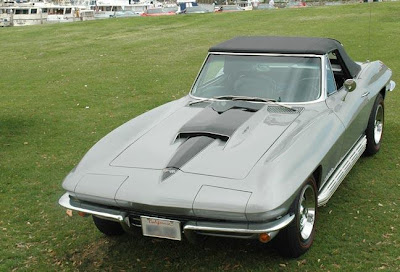
The Chevrolet Corvette C2 is a sports car designed by Larry Shinoda under the styling direction of Bill Mitchell, and produced between 1963 and 1967. It is the second generation or mid-year Chevrolet Corvette built and marketed by Chevrolet.
1963 would see the introduction of the new Corvette Sting Ray coupé with its distinctive split rear window and fake hood vents as well as an independent rear suspension. The split rear window was discontinued in 1964 due to safety concerns. Because they made the design too busy, the hood vents were also cut. Power for 1963 was at 365 hp (272 kW) hitting 375 hp (280 kW) in 1964.
Four-wheel disc brakes were introduced in 1965, as was a "big-block" engine option (the 396 in³ (6.5 L) V8). Side exhaust pipes appeared on the 1965 Stingray and persisted through 1969. Chevrolet would up the ante in 1966 with the introduction of an even larger 427 in³ (7 L) version, creating what would be one of the most collectible Corvettes ever. 1967 saw a L88 version of the 427 introduced which was rated at 430 hp (321 kW), but unofficial estimates place the actual output at 550 hp (410 kW) or more. Only twenty such engines were placed in the 1967 Corvette, and the cars can fetch US$600,000 or more in auction today. From 1967-1969, the 1282 cfm Holley triple two-barrel carbuetor, or Tri-Power, was available on the 427. The 1967 Corvette originally was going to be the first of the C3 generation; however, due to delays the C3 had to be put off until 1968. Other early options available on the C2 included AM-FM radio (mid 1963), air conditioning (1963), telescopic wheel (1965), head rests, presumably to prevent whiplash (1966).
The 1965 introduction of the 425HP 396 c.i. big block was ultimately the harbinger of doom for the Rochester Fuel injection system. The 396 425HP option cost $145. The 327-370HP Fuelie option cost $500. Few people could justify spending $355 more, for 55 hp less. When less than a thousand fuelie cars were built in 1965, Chevy stopped the program. It was indeed short sighted. Chevy was way ahead of its time and had they continued every car that says Lucas or Bosch Fuel injection now, may have said Rochester. As of this writing GM does not make any carburated cars.
In 2004, Sports Car International named the Stingray number five on the list of Top Sports Cars of the 1960s.
The design of this generation had several inspirations. The first was the contemporary Jaguar E-Type, of which Mitchell owned one and enjoyed driving it frequently. Bill Mitchell also sponsored a car known as the "Mitchell Sting Ray" in 1959, because Chevrolet no longer participated in factory racing. This vehicle had the largest impact on the styling of this generation, although it had no top and didn't give away what the coupe would look like. The third inspiration was a mako shark that Mitchell caught while deep-sea fishing.

via